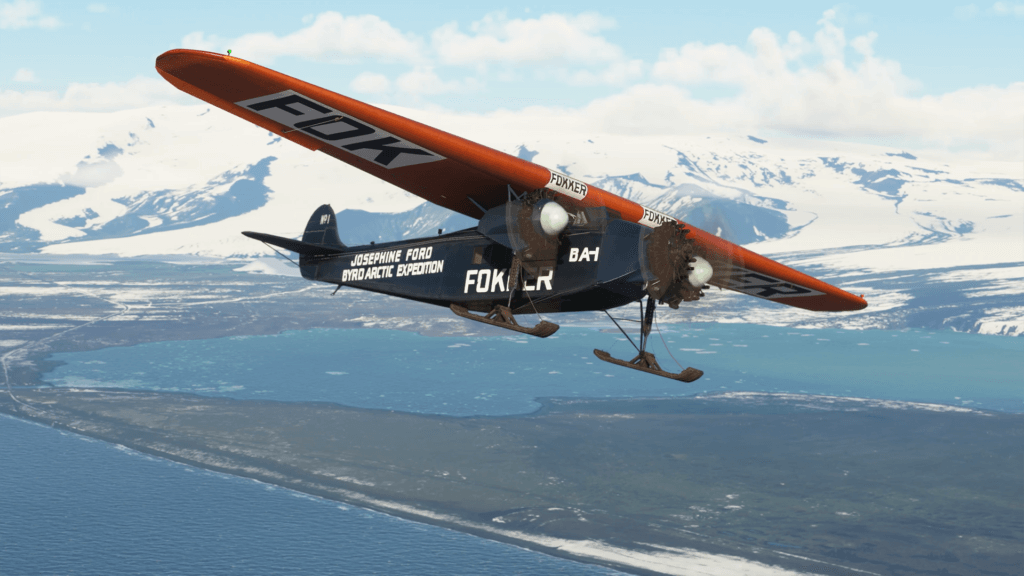We are proud to release the second of our Local Legends series of famous historical aircraft, the Fokker F.VII today. An 8-passenger airliner first flown in 1924 and designed by German aeronautical engineer Walther Rethel for the Fokker Aircraft Company of The Netherlands, the first five F.VIIs produced were driven by a single engine only. It was in this configuration that Dutch flag carrier KLM completed the first ever flight from The Netherlands to the Dutch East Indies (present-day Indonesia).
After determining that a single-engine was unreliable and underpowered, legendary Dutch aircraft pioneer Anthony Fokker tasked his company’s chief engineer Reinhold Platz with converting the type into a three-engine configuration. The resulting design revision, designated the Fokker F.VIIa/3m (more commonly referred to as the “Fokker Trimotor”), would be the aircraft chosen for several historic flights and aviation firsts during the late 1920s. One of these aircraft, a Fokker F.VII named “Southern Cross”, played an especially important role in the history of aviation of the country featured in World Update 7: Australia. Two other Fokker F.VIIs also achieved global fame during this period: the “Josephine Ford” and the “Friendship”.
Southern Cross
We’re proud to pair World Update 7: Australia with a new Local Legend that was famous for not one, but two aviation firsts in that country’s history. On May 31, 1928, a Fokker F.VII named “Southern Cross” (after the constellation that appears on Australia’s flag), took off from Oakland, California heading westbound out over the Pacific Ocean. On board were pilots Charles Kingsford-Smith and Charles Ulm, navigator Harry Lyon, and radio operator James Warner. Flying via Honolulu, Hawaii and Suva, Fiji, the Southern Cross successfully reached its intended destination of Brisbane, Australia ten days later, covering a distance of 6,300 nautical miles and completing the first transpacific flight between the United States and Australia. The crew were greeted in Brisbane by a crowd of over 25,000 eager supporters.
Four months later, Kingsford-Smith, Ulm, and pilot/navigator Gordon Taylor made history in the Southern Cross again, this time becoming the first aviators to fly across the Tasman Sea that separates Australia from neighboring country New Zealand. On September 11, 1928, they departed from Richmond, New South Wales and landed in Christchurch on New Zealands’s South Island 14h25m later after covering a distance of 1,442 nautical miles. As with their earlier transpacific flight, a huge crowd of well-wishers, this time estimated to exceed 30,000 people, was waiting to greet the Southern Cross upon its arrival at Christchurch.
Given its importance in the history of Australian aviation, Kingsford-Smith ensured ownership of the plane was transferred to the government of Australia for public display in a museum. Visitors to Brisbane Airport (ICAO: YBBN) can view the historic Southern Cross in a glass hangar memorial to Sir Charles Kingsford-Smith.
Above: the historic Southern Cross at Brisbane Airport. Photo: Jim Thurstan
Above: close-up of the Southern Cross’s engines at Brisbane Airport. Photo: Jim Thurstan
In addition to the actual Southern Cross on display at Brisbane Airport, a group of Australian aviation enthusiasts, the Historical Aircraft Restoration Society, are currently in the process of repairing a damaged Fokker F.VII Trimotor called the Southern Cross II. The team of volunteers, under the direction of project manager Jim Thurstan, are outfitting it with a replica livery to match the historic Southern Cross and restoring the plane to airworthy condition. As of early 2022, the aircraft has successfully completed taxi tests on the ground, and the team is hopeful it will get airborne this year.
Above: the Fokker F.VII ”Southern Cross II”. Photo: Jim Thurstan
Josephine Ford
The 1910s and 20s were the heyday of polar exploration. Competing Antarctic expeditions led by Norwegian Roald Amundsen and Englishman Robert Scott from 1910-1912 attracted a great deal of public interest, with Amundsen’s team ultimately being the first to reach the South Pole. A decade later, Amundsen would attempt to repeat this feat and become the first confirmed human to reach the geographic North Pole, only this time by air. Flying in the rigid airship Norge, Amundsen set out from the Norwegian island of Spitsbergen high in the Arctic Ocean on May 11, 1926 and overflew the North Pole a day later on May 12.
However, as with Amundsen’s competition with Scott to become the first to reach the South Pole a decade earlier, another rival expedition was also attempting to reach the North Pole first. Robert Byrd and Floyd Bennett of the United States Navy took off from Spitsbergen just two days before Amundsen, also en route to the North Pole. Instead of using an airship, however, they opted to fly a Fokker F.VII named “Josephine Ford”. The plane’s namesake was the daughter of Edsel Ford, then-president of the Ford Motor Company, who had provided financial sponsorship for their expedition.
Above: the Fokker F.VII ”Josephine Ford” at the Henry Ford Museum in Detroit, Michigan.
Byrd and Bennett returned to Spitsbergen 16 hours later after flying over 1,300 nautical miles, claiming to be the first to overfly the geographic North Pole. The two explorers became celebrated national heroes, and each were awarded the Medal of Honor by President Calvin Coolidge in recognition of their accomplishment. However, almost immediately, their claim of flying over the North Pole was met with dispute and controversy, perhaps motivated by supporters of Amundsen who would be recognized as the first person to reach both poles if Byrd’s expedition was proven to have fallen short of its target.
Even today, nearly a century later, there is no definitive proof beyond only the word of Byrd and Bennett that they actually reached the North Pole. Detractors point to the expedition’s logbook which contains contradictory information from the official expedition report Byrd later submitted to the National Geographic Society. In the logbook, there is an entry that was erased but remains legible. If this deleted entry is accurate, it records a sextant reading and position fix that would place the most northerly point reached by their expedition only 80% of the way from Spitsbergen to the geographic North Pole. Barring the discovery of any new evidence, it is unlikely that we will ever know for certain if Byrd and Bennett were actually successful in their North Pole expedition aboard the Josephine Ford or if they falsified their claim. In either case, the plane is still a fascinating object of aviation history and is now on permanent display at the Henry Ford Museum in Detroit, Michigan.
Friendship
A single 1928 flight on board a Fokker F.VII named “Friendship” turned a little-known aviator from Kansas into a global celebrity: Amelia Earhart. Though she did not personally fly the plane herself, this flight saw Earhart become the first woman to journey across the Atlantic by air.
Upon their return to the United States, pilots Bill Stultz, Lou Gordon, and Earhart received a ticker-tape parade in Manhattan and a reception with President Coolidge at the White House. Not wanting to be remembered in the history books as merely a passenger, Amelia subsequently devoted herself to completing many pioneering flights for women and set numerous aviation records, including repeating the transatlantic voyage in 1932, only this time as a solo pilot – a first for women’s aviation.
By all rights, the Friendship should be on public display at in an air museum given the important role it played in the history of aviation; however, the fate of the plane remains unknown. Conflicting sources state that it was either scrapped and stripped for spare parts in 1932 or destroyed in a fire in 1934. Either way, this famous aircraft is now forever lost to time.
Above: The Fokker F.VII “Friendship” as it appears in Microsoft Flight Simulator
We spoke with Douglas Westfall, a historian who has written several books about Earhart, to describe the significance of her transatlantic flight on the Friendship. Here is his response:
“In 1928, it was suggested by publisher George Putnam of Putnam & Sons, that the ‘Friendship’ flight from America to England should have a woman aboard although flown by Bill Stultz and Lou Gordon. Amelia Earhart was deemed the right one to do so as she had been flying for eight years and had owned two aircraft at this time and had an aviation world record for altitude.
Putnam had published Charles Lindbergh’s book ‘The Flight’ the year before and he was interested in making a newsworthy book from this flight as well. The significance of that flight for Earhart was three-fold:
1) Meeting her future husband. Putnam at the time was married to the Smith-Binney Crayola Heiress and he left her for Earhart. Putnam would then sell out his portion of the publishing firm, to become Earhart’s personal manager and promoter.
2) The Fokker F.VII had been modified with flotation pontoons for safety as they were crossing the Atlantic Ocean. The added drag however, caused them to use most of their fuel when they reached Wales.
3) For Earhart however, this was the beginning of the end. She would disappear only nine years later on her ‘World Flight’. By 1936, Putnam and Earhart, then living in North Hollywood, were broke. All the book deals, promotions, and sponsorships were gone. So they concocted the World Flight to make her 16th world record — and fill their coffers.”
Whether you want to re-create the pioneering flights of Sir Charles Kingsford-Smith in the Southern Cross, attempt Robert Byrd’s polar expedition from Spitsbergen in the Josephine Ford, traverse the Atlantic like Amelia Earhart in the Friendship, or fly over any other location in the world in a beautiful vintage aircraft, we’re sure you’ll love Local Legend II: Fokker F.VII. The plane is available now in the Marketplace for both PC and Xbox for USD $14.99.

